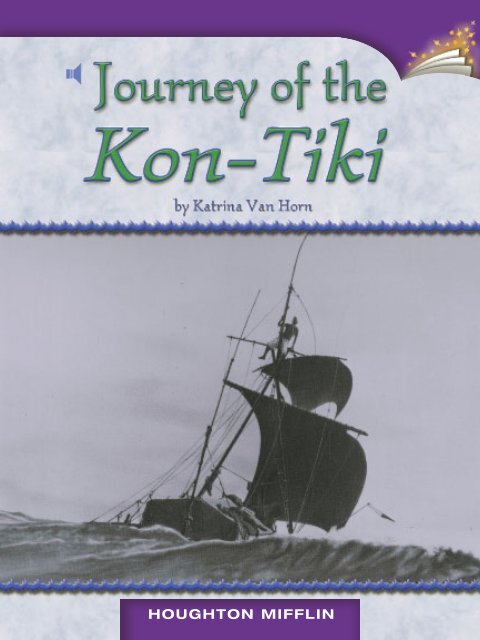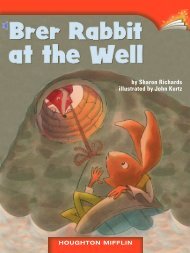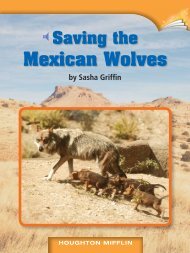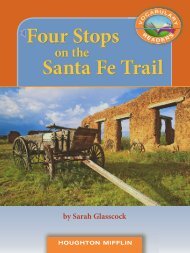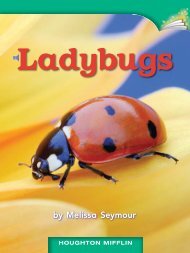You also want an ePaper? Increase the reach of your titles
YUMPU automatically turns print PDFs into web optimized ePapers that Google loves.
HOUGHTON MIFFLIN
y Katrina Van Horn<br />
ILLUSTRATION CREDIT: Joe LeMonnier<br />
PHOTOGRAPHY CREDITS: Cover Getty Images. 1 (detail) C.3.c.8 f.371 North Carolina, titled ‘Virginiae item et Floridae’,<br />
from <strong>the</strong> Mercator ‘Atlas...’ <strong>of</strong> 1606, pub. by Jodocus Hondius, 1619 (hand coloured engraving) (see also 81957, 81958 &<br />
81959),/British Library, London, UK, © British Library Board. All Rights Reserved/The Bridgeman Art Library. 2 (l) © Digital<br />
Stock. (r) © Shutterstock. 3 (r) © Digital Stock. (b) (detail) C.3.c.8 f.371 North Carolina, titled ‘Virginiae item et Floridae’,<br />
from <strong>the</strong> Mercator ‘Atlas...’ <strong>of</strong> 1606, pub. by Jodocus Hondius, 1619 (hand coloured engraving) (see also 81957, 81958 &<br />
81959), / British Library, London, UK, © British Library Board. All Rights Reserved/The Bridgeman Art Library. (4) (l) ©<br />
Digital Stock. 4–5 Mark Downey. 5 (r) © Digital Stock. 6 (l) © Digital Stock. (r) The <strong>Kon</strong>-<strong>Tiki</strong> Museum, Oslo. 8 (l) © Digital<br />
Stock. (b) The <strong>Kon</strong>-<strong>Tiki</strong> Museum, Oslo. 9 (r) © Digital Stock. (bottom coconut) Siede Preis. (top coconut) © Shutterstock.<br />
10 ( l) © Digital Stock. (b) Hulton Archive/Getty Images. 11 (r) © Digital Stock. (t) Getty Images. 12 (l) © Digital Stock. (t)<br />
© Flip Nicklin/Minden Pictures. 13 © Digital Stock. 14 (l) © Digital Stock. (b) © Fotoreport Greeë/dpa/Corbis.<br />
Copyright © by Houghton Mifflin Harcourt Publishing Company<br />
All rights reserved. No part <strong>of</strong> this work may be reproduced or transmitted in any form or by any means, electronic or<br />
mechanical, including photocopying or recording, or by any information storage and retrieval system, without <strong>the</strong> prior<br />
written permission <strong>of</strong> <strong>the</strong> copyright owner unless such copying is expressly permitted by federal copyright law. Requests<br />
for permission to make copies <strong>of</strong> any part <strong>of</strong> <strong>the</strong> work should be addressed to Houghton Mifflin Harcourt School Publishers,<br />
Attn: Permissions, 6277 Sea Harbor Drive, Orlando, Florida 32887-6777.<br />
Printed in China<br />
ISBN-13: 978-0-547-01862-1<br />
ISBN-10: 0-547-01862-2<br />
1 2 3 4 5 6 7 8 0940 18 17 16 15 14 13 12 11<br />
If you have received <strong>the</strong>se materials as examination copies free <strong>of</strong> charge, Houghton Mifflin Harcourt School Publishers<br />
retains title to <strong>the</strong> materials and <strong>the</strong>y may not be resold. Resale <strong>of</strong> examination copies is strictly prohibited.<br />
Possession <strong>of</strong> this publication in print format does not entitle users to convert this publication, or any portion <strong>of</strong> it, into<br />
electronic format.
2<br />
Table <strong>of</strong> Contents<br />
Introduction 3<br />
An Idea is Born 4<br />
Building <strong>the</strong> <strong>Kon</strong>-<strong>Tiki</strong> 6<br />
Supplies for <strong>the</strong> <strong>Journey</strong> 9<br />
Setting Sail 10<br />
Adventures at Sea 11<br />
The <strong>Journey</strong> Ends 13
Introduction<br />
Some people make journeys to increase <strong>the</strong>ir<br />
understanding <strong>of</strong> <strong>the</strong> world, past or present. O<strong>the</strong>r<br />
people make journeys to test <strong>the</strong>mselves—to<br />
find out what <strong>the</strong>y’re made <strong>of</strong> and what <strong>the</strong>y can<br />
achieve. Some hope to do both.<br />
Thor Heyerdahl (HAY er dahl) falls into this<br />
third category.<br />
Heyerdahl was an explorer from Norway.<br />
He spent much <strong>of</strong> his time dreaming up journeys,<br />
planning journeys, and making journeys.<br />
So when he got <strong>the</strong> idea to build a raft and sail<br />
across <strong>the</strong> ocean, it seemed pretty normal—for<br />
him. Nei<strong>the</strong>r Heyerdahl nor anyone else guessed<br />
this journey would become one <strong>of</strong> <strong>the</strong> most famous<br />
adventures ever.<br />
3
4<br />
An Idea is Born<br />
Heyerdahl was curious about everything. But<br />
one thing interested him most: how animals and<br />
people first came to inhabit Polynesia, a group <strong>of</strong><br />
islands in <strong>the</strong> south Pacific Ocean.<br />
In <strong>the</strong> late 1930s, Heyerdahl spent a year living<br />
in Polynesia. While he was <strong>the</strong>re, he studied <strong>the</strong><br />
islands’ plants and animals. He noticed <strong>the</strong>y were<br />
a lot like <strong>the</strong> plants and animals found in South<br />
America. Heyerdahl figured out that winds and<br />
ocean currents from South America probably<br />
carried many <strong>of</strong> <strong>the</strong>se species to <strong>the</strong> islands.<br />
That gave Heyerdahl an idea: Maybe <strong>the</strong> first<br />
human settlers in Polynesia came from South<br />
America, too.<br />
Most scientists believed Polynesia’s first settlers<br />
came from Asia, not America. Heyerdahl decided<br />
to prove <strong>the</strong>y were wrong—or at least prove that<br />
his idea could be right.
Asia<br />
Australia<br />
Antarctica<br />
P O L Y N E S I A<br />
PACIFIC OCEAN<br />
North<br />
America<br />
Peru<br />
Equator<br />
South<br />
America<br />
Did early settlers in Polynesia come from South America?<br />
But how? There was only one way, as<br />
Heyerdahl saw it. He’d have to travel from South<br />
America to Polynesia himself, just as <strong>the</strong> first<br />
settlers might have done. But he would not go on<br />
an airplane or a ship.<br />
No, he’d have to get <strong>the</strong>re on a raft.<br />
5
Building <strong>the</strong> <strong>Kon</strong>-<strong>Tiki</strong><br />
Heyerdahl and a crew <strong>of</strong> five went to Peru in<br />
South America. There <strong>the</strong>y began to build <strong>the</strong><br />
raft <strong>the</strong>y hoped would take <strong>the</strong>m west across <strong>the</strong><br />
Pacific Ocean to Polynesia—4,300 miles away!<br />
This drawing shows a balsa wood raft from Ecuador in<br />
South America. Heyerdahl based his raft on drawings<br />
like this.
Heyerdahl studied drawings from hundreds<br />
<strong>of</strong> years ago, when <strong>the</strong> Spanish came to South<br />
America. He wanted to find out exactly what kind<br />
<strong>of</strong> materials and building methods people in South<br />
America used to make rafts back <strong>the</strong>n. Heyerdahl<br />
was determined to build a raft exactly like one<br />
those early people might have built.<br />
The crew made <strong>the</strong>ir raft from balsa wood,<br />
which is plentiful in South America. They tied<br />
toge<strong>the</strong>r nine huge tree trunks. Each one was<br />
about 45 feet long and 2 feet wide. They laid<br />
o<strong>the</strong>r logs crosswise to make <strong>the</strong> raft stronger.<br />
They wedged pieces <strong>of</strong> pine between <strong>the</strong> logs<br />
to fill any big gaps.<br />
7
8<br />
Then <strong>the</strong> crew made a mast and a sail. They<br />
also made a giant oar, so <strong>the</strong>y could row when<br />
<strong>the</strong>re was no wind for sailing. In <strong>the</strong> rear section<br />
<strong>of</strong> <strong>the</strong> raft, <strong>the</strong>y built a cabin from bamboo to<br />
protect <strong>the</strong>m in bad wea<strong>the</strong>r. They made <strong>the</strong><br />
cabin’s ro<strong>of</strong> from banana leaves.<br />
Heyerdahl <strong>the</strong>n gave <strong>the</strong> raft a name: <strong>Kon</strong>-<strong>Tiki</strong>.<br />
It was <strong>the</strong> name <strong>of</strong> a leader in ancient Peru who<br />
had used a balsa-wood raft to escape his enemies.<br />
Heyerdahl worked with helpers to build his raft.
Supplies for <strong>the</strong> <strong>Journey</strong><br />
Supplies for <strong>the</strong> <strong>Journey</strong><br />
Heyerdahl and his crew thought very<br />
carefully about what supplies to bring on<br />
<strong>the</strong>ir journey. Fresh water was first on <strong>the</strong>ir<br />
list. They couldn’t survive long without it.<br />
Hollow pieces <strong>of</strong> bamboo served as tanks to<br />
hold <strong>the</strong> water. The crew also brought along<br />
coconuts and o<strong>the</strong>r fruit, sweet potatoes, and<br />
some canned foods. They knew <strong>the</strong>y could<br />
catch plenty <strong>of</strong> fish along <strong>the</strong> way.<br />
The crew had only two kinds <strong>of</strong> modern<br />
equipment: a radio and watches. Fortunately,<br />
one <strong>of</strong> <strong>the</strong> crew members was an engineer<br />
who was very good with measurements. He<br />
could help estimate <strong>the</strong> raft’s<br />
location by figuring out <strong>the</strong><br />
location <strong>of</strong> <strong>the</strong> sun, moon,<br />
and stars.<br />
9
10<br />
Setting Sail<br />
On April 28, 1947, <strong>the</strong> <strong>Kon</strong>-<strong>Tiki</strong> left Peru and<br />
headed out to sea, bound for Polynesia. After<br />
reaching deep ocean, <strong>the</strong> raft was carried along<br />
by <strong>the</strong> Humboldt Current. The Humboldt is <strong>the</strong><br />
same strong current that carried plants and animals<br />
from South America to <strong>the</strong> islands.<br />
A crew member<br />
near <strong>Kon</strong>-<strong>Tiki</strong>’s sail<br />
during <strong>the</strong> voyage.
<strong>Kon</strong>-<strong>Tiki</strong> and its crew faced danger far out in <strong>the</strong> Pacific.<br />
Adventures at Sea<br />
During <strong>the</strong>ir journey, <strong>the</strong> <strong>Kon</strong>-<strong>Tiki</strong> crew had at<br />
least one brush with disaster. Far out at sea, <strong>the</strong>y<br />
spotted a whale shark. The enormous creature<br />
swam toward <strong>the</strong> raft and <strong>the</strong>n down, directly<br />
underneath it. The crew could see <strong>the</strong> slopes <strong>of</strong><br />
<strong>the</strong> shark’s back curving down to its tail on one<br />
end <strong>of</strong> <strong>the</strong> raft, and down to its giant, flat head on<br />
<strong>the</strong> o<strong>the</strong>r end. If <strong>the</strong> shark made a sudden move,<br />
it could create a huge wave that would hit <strong>the</strong> raft<br />
like an avalanche. Or <strong>the</strong> shark might lift <strong>the</strong> raft<br />
into <strong>the</strong> air, flipping it over.<br />
11
12<br />
A whale shark like this one almost brought <strong>Kon</strong>-<strong>Tiki</strong>’s<br />
voyage to a halt.<br />
Instead, <strong>the</strong> whale shark swam out from under<br />
<strong>the</strong> raft and began swimming in circles around it—<br />
for more than an hour! The raft couldn’t budge<br />
until <strong>the</strong> shark finally swam away. In <strong>the</strong> end, it<br />
did no harm. Maybe it was merely trying to make<br />
friends with <strong>the</strong> giant raft!
The <strong>Journey</strong> Ends<br />
The <strong>Journey</strong> Ends<br />
In late July, <strong>the</strong> crew saw birds flying at<br />
high altitudes in <strong>the</strong> sky. It was a clue that<br />
land was near. And on July 30th, <strong>the</strong> crew<br />
finally got a glimpse <strong>of</strong> land—Polynesia!<br />
As <strong>the</strong> <strong>Kon</strong>-<strong>Tiki</strong> approached <strong>the</strong><br />
islands, it struck a reef, or underwater wall.<br />
Polynesian natives paddled boats out to<br />
meet <strong>the</strong> crew. They looked over <strong>the</strong> raft<br />
and asked in sign language, “Where’s <strong>the</strong><br />
engine?” The crew explained <strong>the</strong>re was no<br />
engine. The crew’s new Polynesian friends<br />
were shocked.<br />
Thor Heyerdahl’s journey on <strong>the</strong><br />
<strong>Kon</strong>-<strong>Tiki</strong> fascinated people around <strong>the</strong><br />
world. Heyerdahl turned <strong>the</strong> story <strong>of</strong> his<br />
adventure into a best-selling book.<br />
But had <strong>the</strong> explorer succeeded in<br />
proving what he had set out to prove? Had<br />
he proved that Polynesia’s first settlers<br />
traveled <strong>the</strong>re from South America?<br />
13
Well, no.<br />
Most scientists thought Heyerdahl’s idea was<br />
just plain wrong, and his journey did nothing to<br />
change <strong>the</strong>ir minds. They still believed people first<br />
migrated to Polynesia from Asia, not from South<br />
America. They had plenty <strong>of</strong> scientific evidence to<br />
back <strong>the</strong>m up.<br />
But no one denies this: <strong>the</strong> <strong>Kon</strong>-<strong>Tiki</strong>’s journey<br />
was an incredible feat, and adventurer Thor<br />
Heyerdahl had <strong>the</strong> daring, imagination, and<br />
determination <strong>of</strong> a true explorer.<br />
An older Thor Heyerdahl stood in front <strong>of</strong> <strong>Kon</strong>-<strong>Tiki</strong> years<br />
after his voyage.<br />
14
Responding<br />
TARGET SKILL Text and Graphic<br />
Features How did text and graphic<br />
features help your understanding <strong>of</strong> this<br />
story? Copy <strong>the</strong> chart below. Complete <strong>the</strong><br />
chart by writing <strong>the</strong> purpose <strong>of</strong> <strong>the</strong> o<strong>the</strong>r<br />
two features in this book.<br />
Maps Drawings Headings<br />
Purpose<br />
Help me see<br />
where <strong>the</strong><br />
story takes<br />
place.<br />
Purpose<br />
?<br />
Purpose<br />
?<br />
Write About It<br />
Text to Self Imagine being a crew member<br />
on <strong>the</strong> <strong>Kon</strong>-<strong>Tiki</strong>. Write a fictional story<br />
telling what it might have been like. Use<br />
descriptive words to help readers picture<br />
what happens on <strong>the</strong> raft.<br />
15
16<br />
altitude<br />
approached<br />
avalanche<br />
equipment<br />
halt<br />
TARGET VOCABULARY<br />
increase<br />
section<br />
slopes<br />
succeed<br />
tanks<br />
TARGET SKILL Text and Graphic Features<br />
Tell how words, photos, and art work toge<strong>the</strong>r.<br />
TARGET STRATEGY Infer/Predict Use clues to<br />
figure out more about <strong>the</strong> selection.<br />
GENRE Informational text gives factual<br />
information about a topic.
Level: O<br />
DRA: 38<br />
Genre:<br />
Informational<br />
Strategy:<br />
Question<br />
Skill:<br />
Text and Graphic Features<br />
Word Count: 1,040<br />
3.5.<strong>25</strong><br />
HOUGHTON MIFFLIN<br />
Online Leveled Books<br />
ISBN-13: 978-0-547-01862-1<br />
ISBN-10: 0-547-01862-2<br />
1031710


